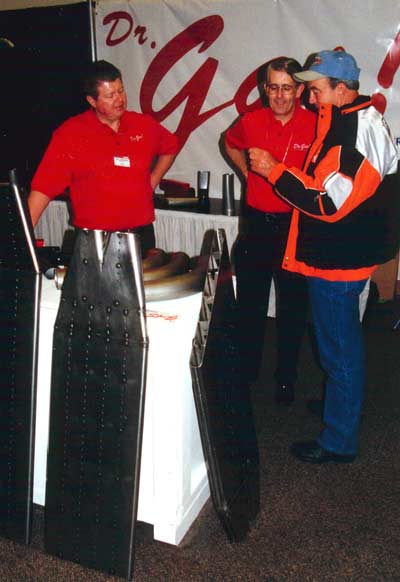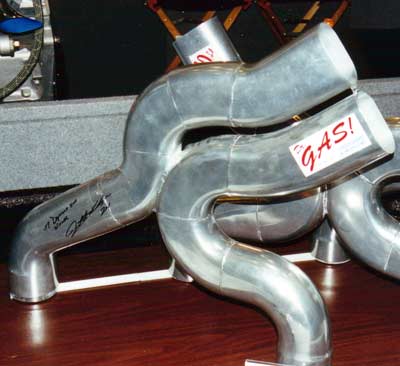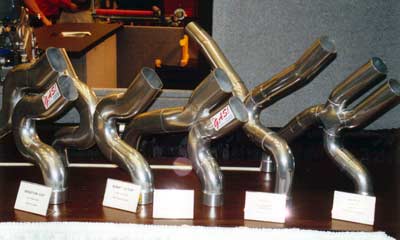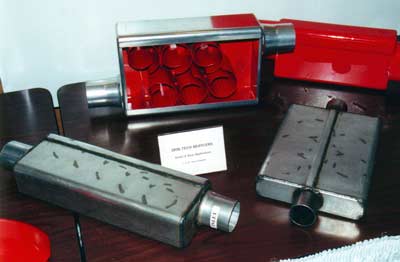INSIDE
RACING
T E C H N O L O G Y
IRT Home
IRT Home
News Page
Contents Page
Newsletter &
Books
email Paul
Boyd Butler Is "Dr. Gas"
Sterling Marlin won the 1995 Daytona 500 Winston Cup race with a car that turned heads with its engine sound, a smooth, high-pitched whine compared with the burbling rumble characteristic of most production-based V-8 engines. Later that year Dema Elgin, a friend and well-known camshaft developer who has a shop in Redwood City near where we lived then, filled me in on some NASCAR engine tidbits and told me I should call a guy in Sandy, Utah and talk to him about exhaust systems. That led to an interesting conversation with Boyd Butler also known as Dr. Gas and I wrote about him and his products in the September, 1995 issue of TV MOTORSPORTS.
Although Boyd and I have had phone conversations over the years I met him for the first time at the Performance Racing Industries show in Indianapolis a few weeks ago. Boyd has built a successful business with some innovative ideas.
Here are some photos I took at PRI and following is a slightly edited version of that article I wrote in September '95.

Boyd Butler shakes hands with a customer in the Dr. Gas booth at the Performance Racing Industries trade show in Indianapolis. The guy in between them is Winston Cup driver Joe Nemechek.

Boyd talks to a customer who has a Dr. Gas exhaust system on a street car. Those tall, shiny things are exhaust pipes, called Boom Tubes, for Winston cup cars. They exit under the left side of the cars in front of the rear tire.

This is an Equal Length Single Side Exit System for Winston cup cars. Headers from the engine fit into the ends sitting on the table and a Boom Tube fits on the upper end. Notice the transition from round to oval cross section. That's Jeff Gordon's signature on that lower left branch.

A display of an assortment of crossover pipes.

Dr. Gas makes a line of race mufflers called Spin Tech mufflers. Boyd has patented this concept.
Contact Dr. Gas at PO Box 499, Sandy, UT 84091, 801-563-1110, www.drgas.com
Boyd Butler Is "Dr. Gas"
In the summer of 1995 Dema Elgin told me he had heard of a guy who was working on exhaust systems and was responsible for the strange-sounding exhaust on the NASCAR Winston Cup car driven by Sterling Marlin and owned by Morgan-McClure racing. The Kodak-sponsored number 4 Chevrolet car was getting a lot of attention because the exhaust sounded different, and it was going fast. They won the Daytona 500 and Dr. Jerry Punch interviewed Tony Glover, Marlin's crew chief. The Doc asked Glover if the sound was due to some special 180 degree headers? Glover, tongue firmly in cheek, answered, "Actually they're more like 140 degrees." Glover went on to credit hard work by their engine builder, Runt Pitman. Runt must have found something, because Marlin won two of the four restrictor-plate races this year.
Dema gave me a phone number and I called Boyd Butler, owner of Dr. Gas, a company that develops and sells exhaust systems. Boyd, like myself is an engineer with an aerospace background. He told me he started trying to contact NASCAR teams in the early 90s but had problems getting their attention. "They just wouldn't return phone calls," he said. "Most of the time I couldn't get past the receptionist. Richard Childress Racing has a voice mail system that I got lost in every time I called. I never did get through to a human."
Boyd put some ads in Circle Track magazine and Mark Giles, exhaust system fabricator for Morgan-McClure Racing, called with some questions. Boyd followed up with him and, in January of '95, finally made a couple of sets of pipes for them to dyno test. They saw a 3 hp improvement, and Boyd got a call on a Saturday afternoon about a week before qualifying for the Daytona 500. "Basically they said bring all the tubing you can carry and get here as soon as you can," Boyd said. "Their shop is in rural Virginia, so I had to fly into Johnson City, Tenn. and drive to their place. I spent a frantic few days putting some systems together. I had always worked with round tubing, but they have to use oval tubing because they run their cars so close to the ground. I had to learn how to work with the oval stuff, and I learned in a hurry.
As I was driving off they were loading the cars into the transport. I made a system for the Cup car and one for a car they ran in the Busch Clash. The final configuration gave them an extra 4.5 hp, a one percent improvement. They usually have to find several small performance gains to make an engine that much better.
"That next Saturday night I was watching Daytona 500 qualifying on ESPN, and there was Benny Parsons and the other announcers talking about the weird-sounding number-4 car. I guess it worked. Sterling won his qualifying race and won the 500.
"After that I got calls from all the teams, but Larry McClure said he wanted an exclusive deal for that season. That turned out to be a blessing. I got paid some money, and it gave me time to develop the concept without a lot of pressure. Learning to work with oval tubing is a big deal. I also had time to design and build tooling that helps a lot. Ground clearance is very critical on Cup cars. They spend a lot of time and money getting everything, including the driver, as low in the car as it will go. The lower the center of gravity, the less weight transfer they get. That's very important.
"Next year [1996] I'll be able to work for other teams. The new IROC cars will be Pontiac Firebirds, and they'll have our exhaust system. They want our system just because it sounds good. We also make mufflers and exhaust systems for high performance street cars. Our goal is to make product that squeezes maximum performance out of the exhaust system."
How Does It Work?
I asked Boyd to explain what his exhaust system does to increase power. "It uses energy--pressure and temperature--in the exhaust gases to help those gases get out the exhaust pipe a little better. The engine sees a slightly lower pressure in the pipe and that helps get more air through the engine and makes more power.
"A normal V-8 engine like we all drive and like the one that powers all the Winston Cup cars, has a 90-degree crankshaft. There are four connecting rod journals on a V-8 crank, and they're all 90 degrees from each other. This makes a balanced engine, which is important for a passenger car. The Indy car V-8s have 180 degree or "flat" cranks which make a stronger, more reliable engine at high rpms. A 90-degree V-8 engine is the same as two four-cylinder engines hooked to the same crankshaft. On each bank there are two cylinders that fire within 90 degrees of each other. These two exhaust pulses are very close together as they travel through the exhaust pipe. This is the reason some V-8s with dual exhaust pipes have a popping noise you can hear. That's the two pulses arriving at the end of the pipe about the same time. These two pulses can interfere and cost some power.
"You see a cross-over pipe on most V-8s with dual exhaust. This is a pipe that connects the exhaust pipes from the two banks of cylinders. A cross-over pipe smoothes gas flow and lowers sound levels. We've learned how to use it to make some extra power.
"We use a four-into-one header on each bank and do some special stuff to the cross-over pipe so that the high-pressure pulse caused by those two cylinders firing close together is vented through the cross over into the other exhaust pipe when the pressure over there is low. There are some reflected pressure waves that have to be timed right, but the result is a slightly lower pressure in the exhaust system downstream of the cross over. That lower pressure encourages more flow through the engine which makes more power. The modified pressure waves in the exhaust is what makes the unique sound, a higher-frequency sound. That pop sound has been smoothed out. That sound is what says the system is working.
"I've seen dyno tests that show our system broadens the torque curve. With a restrictor-plate motor, the torque falls off really quick when the engine starts to starve for air. Our exhaust systems let them breathe just a little better and at a little higher rpm. I figure we increase the overall volumetric efficiency of the engine by about a half a percent."
I asked Boyd how he got that "Dr. Gas" name for his company. "I had some technical-sounding names that I thought were neat, and I asked a friend of mine what he thought about them. He said he'd tell me the next day, but he couldn't remember any of those names when I called him back. 'Dr. Gas' was kind of a joke, but people remember it so that's what we decided on."